The unusually lofty nave arcades rest on four piers which have capitals of very fine stiff-leafed foliage.
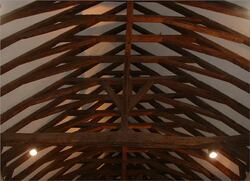
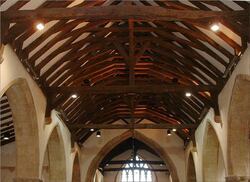 The nave roof is the original one built in 1220 and the trusses are numbered from 1 to 28. The six supports and braces below the main tie beams were placed in position at a later date and possibly completed when new seating and various other repairs were carried out in 1867.
The nave roof is the original one built in 1220 and the trusses are numbered from 1 to 28. The six supports and braces below the main tie beams were placed in position at a later date and possibly completed when new seating and various other repairs were carried out in 1867.
The Chancel
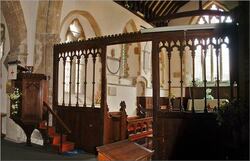 The Chancel Rood Screen consists of three parts, above the base are slender bonded shafts with rounded capitals which suggests that this is one of the rare examples of a late 13th century screen, the upper tracery and embattled beam is later century work. There is a Purbeck marble slab, over three metres in length and placed centrally on the floor of the Chancel, and having on it the matrix of a large cross. It commemorates the Rector (Roger de Marlowe) in whose time the present Chancel was completed. Having been hidden under a carpet for many years this is now on full view.
The Chancel Rood Screen consists of three parts, above the base are slender bonded shafts with rounded capitals which suggests that this is one of the rare examples of a late 13th century screen, the upper tracery and embattled beam is later century work. There is a Purbeck marble slab, over three metres in length and placed centrally on the floor of the Chancel, and having on it the matrix of a large cross. It commemorates the Rector (Roger de Marlowe) in whose time the present Chancel was completed. Having been hidden under a carpet for many years this is now on full view.
Oak choir pews were installed during the 1867 restoration, reproduced after what was assumed to be the original design, traces of which were found when the old fittings were removed. In 2016 these choir stalls were replaced by oak chairs, apart from the seats around the walls.
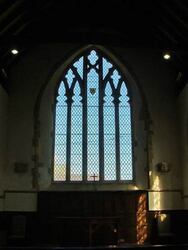 The mullions in the large East window are unusual in that on either side of the central light they are carried up to the head of the arch. The shield towards the top of the window is that of Piers Gaveston, Edward 2nd's favourite, who was made Lord of the Upper Manor and given the gift of the living shortly after being made Earl of Cornwall in 1307. It was recorded by Ashmole when he visited the church in 1665 that this window contained shields of the King, the Prince of Wales and Edmund, Earl of Cornwall.
The mullions in the large East window are unusual in that on either side of the central light they are carried up to the head of the arch. The shield towards the top of the window is that of Piers Gaveston, Edward 2nd's favourite, who was made Lord of the Upper Manor and given the gift of the living shortly after being made Earl of Cornwall in 1307. It was recorded by Ashmole when he visited the church in 1665 that this window contained shields of the King, the Prince of Wales and Edmund, Earl of Cornwall.
The upper parts of the two windows on the north side of the Chancel contain various fragments of contemporary high quality grisaille glass collected from windows in various parts of the church and reassembled by Mr. King of Norwich 1959.
The Chancel roof of 1305 presents a slightly later and more elegant form of crown post construction each post being octagonal in section and having a moulded base and capital. Some of the timbers were replaced when the Chancel was restored in 1932.
The stone sculptures are worthy of notice. The sculpture on the south side of the Chancel arch represents a dragon biting a lady, while that on the north side shows the curled figure of a man with his right hand held to his ear. Adjacent to the priest's doorway on the north side is the figure of a man holding a leather bottle (a jack). This secular piece of work is an insertion, probably at the time of the Reformation. Sculptured heads support the image brackets on either side of the East Window.
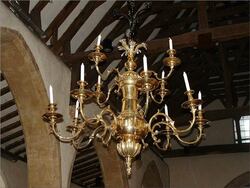
The brass candelabra was a gift from W. Christopher Elderfield in 1766.
North & South Aisle 1275 to 1325:
The Harewell window
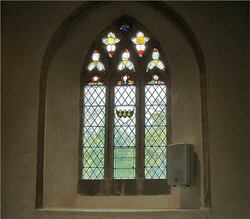 The West window has a double lancet with diamond opening circa 1280. Geometric tracery with quatrefoils circa 1290 can be seen in the Eastern windows of the aisle. The East window of the North aisle has an example of the more advanced tracery circa 1300-1325 which used ogee curves and intersecting mullions. This window is now known as the Harewell window as the descendents in the USA of John de Harewell, 1320-1386, donated the cost of having the window restored and additional stained glass added in 1981.
The West window has a double lancet with diamond opening circa 1280. Geometric tracery with quatrefoils circa 1290 can be seen in the Eastern windows of the aisle. The East window of the North aisle has an example of the more advanced tracery circa 1300-1325 which used ogee curves and intersecting mullions. This window is now known as the Harewell window as the descendents in the USA of John de Harewell, 1320-1386, donated the cost of having the window restored and additional stained glass added in 1981.
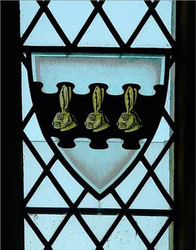 The coat of arms of John de Harewell is in the centre of the window. It was in 1636 that Thomas Foulk Harewell and his brother sailed as colonists to Virginia and over 500 of their descendents were eventually traced all over the USA by J. M. Fletcher and his committee. A large contingent came to the church for the dedication service on the 20th September 1981. Since then many have visited every year to view "our" window.
The coat of arms of John de Harewell is in the centre of the window. It was in 1636 that Thomas Foulk Harewell and his brother sailed as colonists to Virginia and over 500 of their descendents were eventually traced all over the USA by J. M. Fletcher and his committee. A large contingent came to the church for the dedication service on the 20th September 1981. Since then many have visited every year to view "our" window.
The Wild Rose tapestry
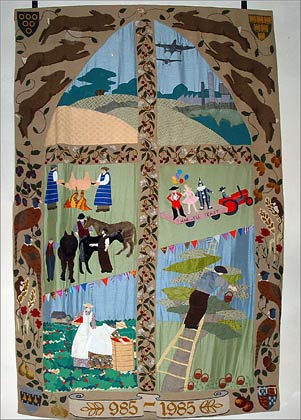 Adjacent to the Harewell window is the Wild Rose Hanging tapestry, designed and worked by ladies and one man from the village as part of the Millennium celebration to commemorate the 1000 years signing of the Royal Charter to the village of Harwell 985-1985.
Adjacent to the Harewell window is the Wild Rose Hanging tapestry, designed and worked by ladies and one man from the village as part of the Millennium celebration to commemorate the 1000 years signing of the Royal Charter to the village of Harwell 985-1985.
A pageant was performed highlighting various stages throughout the 1000 years. Rows of straw bales were provided for the capacity audiences seated on the Rectory lawn. Whilst the Sanctuary was roped off, the interior of the church became a vast changing room to accommodate the 250 members of the parish who took part.
The Gatekeeper tapestry
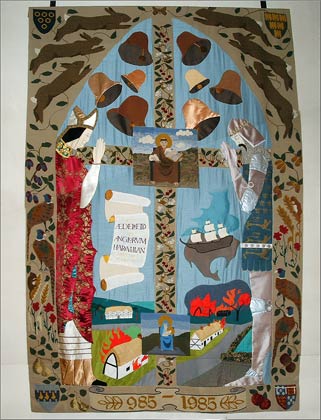 Hanging in the South Aisle is the Gatekeeper Tapestry, the surrounding tapestry design, common to both wall hangings is representative of the fruit, wildlife and flowers found in and around the village. At the top are the hares from which the village name was derived.
Hanging in the South Aisle is the Gatekeeper Tapestry, the surrounding tapestry design, common to both wall hangings is representative of the fruit, wildlife and flowers found in and around the village. At the top are the hares from which the village name was derived.
The shields going clockwise from the top right hand corner are those of Piers Gaveston, the Black Prince, John de Harewell and the Loder family.
The Tower & Bells
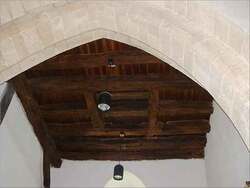 At the base of the tower the original mediaeval timbers can be seen supporting the ringing chamber floor. The West window circa 1200 shows plate tracing and this also occurs on each face of the upper stages of the tower. In the bell chamber itself by standing on the frame, there is a good view of the 8 ringing bells and Sanctus bell.
At the base of the tower the original mediaeval timbers can be seen supporting the ringing chamber floor. The West window circa 1200 shows plate tracing and this also occurs on each face of the upper stages of the tower. In the bell chamber itself by standing on the frame, there is a good view of the 8 ringing bells and Sanctus bell.
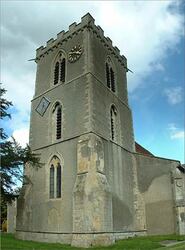 From the top of the tower by looking in a northerly direction it is possible, on a clear day, to see in the distance the spires of the City of Oxford. From this point on the 2nd June 1953 Great Tom was clearly audible swinging from high in Tom Tower Oxford to proclaim the crowning of Queen Elizabeth 2nd.
From the top of the tower by looking in a northerly direction it is possible, on a clear day, to see in the distance the spires of the City of Oxford. From this point on the 2nd June 1953 Great Tom was clearly audible swinging from high in Tom Tower Oxford to proclaim the crowning of Queen Elizabeth 2nd.
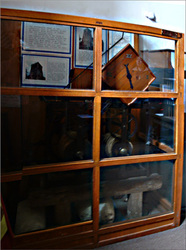 On the west side of the tower is modern the clock given by H. Stuart Baker in commemoration of Valentine Baker, Pilot Officer R.A.F. killed in action 1943. It replaced the clock given in 1703 of which the single handed face can be seen to the right of the tower. The clock mechanism has now been restored and is installed at ground level.
On the west side of the tower is modern the clock given by H. Stuart Baker in commemoration of Valentine Baker, Pilot Officer R.A.F. killed in action 1943. It replaced the clock given in 1703 of which the single handed face can be seen to the right of the tower. The clock mechanism has now been restored and is installed at ground level.
The Church Extension 1975
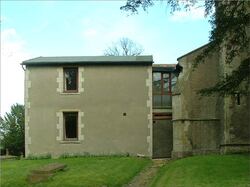 The lower part of the extension provides a room for children's and young people's activities on Sundays and for fellowship, committee and various other meetings during the week. Toilets are provided and facilities were installed for the storage of crockery and provision for the heating of water, etc. Disabled toilet and new kitchen facilities were added in 2006.
The lower part of the extension provides a room for children's and young people's activities on Sundays and for fellowship, committee and various other meetings during the week. Toilets are provided and facilities were installed for the storage of crockery and provision for the heating of water, etc. Disabled toilet and new kitchen facilities were added in 2006.
The upper room has access by means of a staircase inside the church and is the location for the church office, and some meetings. It was during the work of opening the upper wall for access that the remains of timbers were found that formed the balcony that ran across the lower part of the tower removed during work in the 1860's.
The South Door
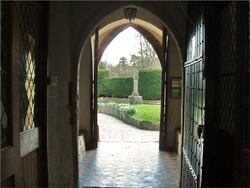
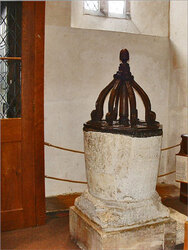 By the South door the tub shaped font which may be a survival from the earlier church or contemporary with the Nave Archades and tower. Behind the font at floor level is the stone coffin lid placed here in 1963. The coffin was found beneath the north side of the nave and the details indicate it to be of the late 12th century period. The coffin was left in situ but the chalice which was inside the coffin and is of lead tin alloy circa 1180-1280, was removed and is on loan to Christ Church Cathedral museum Oxford.
By the South door the tub shaped font which may be a survival from the earlier church or contemporary with the Nave Archades and tower. Behind the font at floor level is the stone coffin lid placed here in 1963. The coffin was found beneath the north side of the nave and the details indicate it to be of the late 12th century period. The coffin was left in situ but the chalice which was inside the coffin and is of lead tin alloy circa 1180-1280, was removed and is on loan to Christ Church Cathedral museum Oxford.
Churchyard
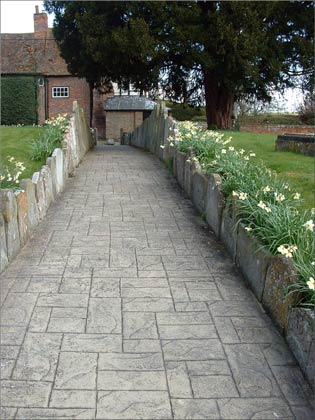
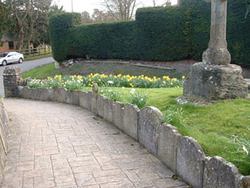 The churchyard was formally closed in 1903, the last burial being in 1896. The present village cemetery is along the pathway leading from the church towards The Cleave.
The churchyard was formally closed in 1903, the last burial being in 1896. The present village cemetery is along the pathway leading from the church towards The Cleave.
The History of the re-positioning of the grave headstones.
In 1930 the person who cut the grass in the church grave yard (with a scythe) complained to the church warden of the dangers of the job because of all the fallen headstones. The pathways leading to and from the church were narrow and the earth on either side of them was crumbling, bringing with it some of the human remains buried there. The roots of two large yew tees, which have since been removed, were also a contributory factor.
The church warden Dr Rice agreed with the incumbent Rev J C Cohen and permission was sought from the Berkshire Deanery and Oxford Diocese to re-site the headstones in order to hold back the banked-up earth, restore the graves and protect the remains of those buried there. As years had passed since anyone had been buried in the graves any first generation relatives had also died. Extensive searches revealed only one relative who 'didn't mind if the headstone was re-sited'.
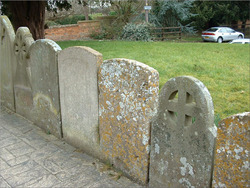
The path running from East to West was done first and later the South path was completed. The headstones are not made of granite or marble and therefore have weathered over the years; however at least 20 of the headstones have been created from concrete in various shapes to complete the task in a sensitive way. No headstone is buried any lower than its original depth.
Documentation
REGISTERS There are separate registers for the periods 1558-1687 and 1688-1812 recording baptisms, marriages (up to 1753) and burials. The earlier one is incomplete due to damage, there are no entries in the second for the years 1690, 1693 and 1694. Otherwise both are well kept; there is a separate register of marriages from 1754-1812. Since 1812 there are separate columns recording Baptisms 1813-44, 1844-67, 1868-1922, 1959 Marriages 1813-37, 1837-1951, 1951-62, 1962 Burials 1813-65, 1866-1943, 1943.
References
General: Keyser, Berks, Bucks & Oxon. Arch.9.18 p.33 (1912)
Victoria County History, Berkshire 3 p.489 (1923)
Walker, Berks, Arch. 9 36 p.8 (1923)
History: Salter, Osney Centulary Vol IV, Oxford Hist. Soc.97 (1934)
White Kenneth, Parochial Antiquities 1818
Black Prince's Register Pt. 1V Hall, Berks, Arch. J 41 p.9 (1937)
Roofs: Howard Arch. J LXXI p.293 (1914)
Fletcher & Spokes Med.d Arch.8 p. 152 (1964)
Bells: Sharpe. Berks Arch.J 45 p.68 (1941)
Rice. Har. Par. Mag (1932)
Coat Of Arms: Spokes Berks Arch. J 39 p.159 (1935)
Greening Lambourn. Armorial Glass of Oxford diocese p.28 (1949)
Vicarage: Fletcher Berks Arch. J 59 p.38 (1961)
Chalice: Fletcher & Spokes Berks Arch.9 61 p.37 (1963 64)
Stone Coffin: Fletcher & Spokes Berks Arch.9 (1963 4)
St. Matthew’s Guidebook: J. M. Fletcher & P. S. Spokes 1963; Revised J. A. B. Gibson 1976, Editor Douglas Jordan 1993
Created from the Church Guidebook by David Evans for the church website, February 2012, and edited by Tony Hughes 2014, 2015 and 2017.